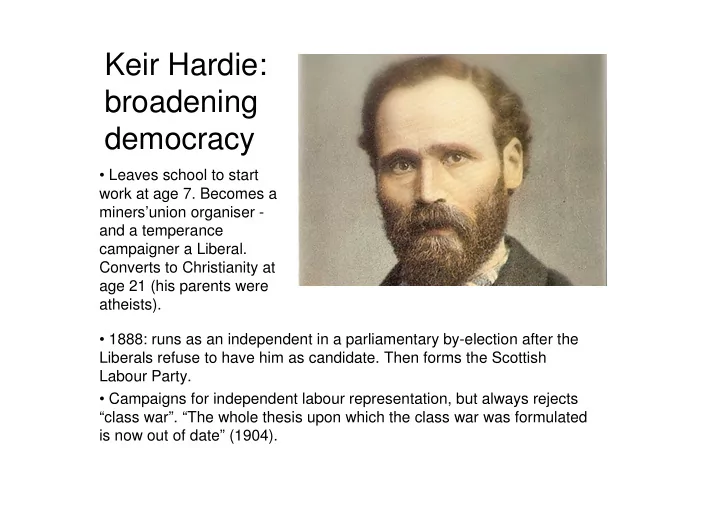

Keir Hardie: broadening democracy • Leaves school to start work at age 7. Becomes a miners’union organiser - and a temperance campaigner a Liberal. Converts to Christianity at age 21 (his parents were atheists). • 1888: runs as an independent in a parliamentary by-election after the Liberals refuse to have him as candidate. Then forms the Scottish Labour Party. • Campaigns for independent labour representation, but always rejects “class war”. “The whole thesis upon which the class war was formulated is now out of date” (1904).
The Independent Labour Party • 1892: for the first time since the Chartists won MPs, three independent labour candidates are elected: John Burns, Havelock Wilson, and Hardie (for West Ham South). All trade-union and working-class MPs before this have been "Lib- Labs", trade-union nominees adopted as official Liberal candidates. • Burns and Wilson are soon absorbed by the Liberals, but Hardie holds firm. • 1893: Hardie and others found Independent Labour Party, designed as a broader, looser party than the SDF. • 1895: All ILP candidates in general election defeated; Hardie loses his seat. (The ILP is, however, winning seats in local government). The Independent Labour Party was the main vehicle for individuals to be active in the Labour Party until 1918 and then the dominant soft-left political faction in Labour Party until it quit Labour in 1932. (Pic: Keir Hardie’s election address, 1895.
Founding the Labour Party • 1899: after years of defeat, Hardie and his friends get motion through TUC to establish a Labour Representation Committee (546,000 to 434,000). • February 1900: Meeting with representatives of trade unions numbering 545,000 (about 45% of TUC), ILP (13,000), SDF (9,000), and Fabians (861) to found a federal body (no individual members) called LRC. LRC’s affiliated TU membership in early 1901 is 340,000. • October 1900: general election dominated by Boer War (which Hardie opposes). Hardie wins (in Merthyr Tydfil); one other Labour MP, Richard Bell, who soon goes over to Liberals. Hardie’s election manifesto in Merthyr, 1906
Taff Vale and • July 1901: Taff Vale judgement: rail union is legally bound to repay any costs caused to the employers by a strike. 1906 This pushes many unions to affiliate to LRC. • January 1906 election: 29 Labour candidates win at general election. "Parliamentary Labour Party" formed with Hardie as leader; pushes Liberals into legislating to reverse “Taff Vale” • 1908: Hardie, tired, hands over Labour leadership to Arthur Henderson. He campaigns for votes for women, for Indian self- rule; opposes World War One; dies in 1915. • 1909: the miners, then by far the biggest union, break from the Liberals and affiliate to Labour, which for the first time now represents the bulk of the unions.
Recommend
More recommend